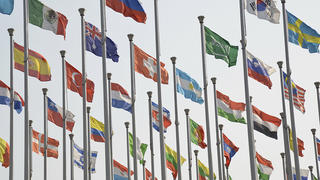Nationally Determined Contributions
10 min read
Nationally determined contributions are a new tool in the fight against . Governments are encouraged to update their objectives every five years and to make them increasingly ambitious. The world's countries played along in the lead-up to the 21 climate talks, but it remains to be seen if they will pursue their efforts.

© THINKSTOCK - All of the world's nations have been invited to present their objectives for fighting against global warming.
One of the COP 21 climate summit's innovations was to ask all the Parties to indicate their intentions concerning emissions reduction and climate finance in writing before the talks began. In all, 186 out of 195 countries submitted what are known as Intended Nationally Determined Contributions (NDCs).
While the NDCs are often backed by domestic policies and legislation, they are not binding at the international level and could not be used as a basis for the Paris Agreement. That said, they provide a reference and will serve as a new baseline against which each country's results will be measured by the other Parties. The Paris Agreement calls on the world's countries to update their nationally determined contributions every five years, and a first meeting will be organized in 2018 to compare the objectives to the reality of . The will also publish a report in 2018 to determine what must be done to keep the global temperature from rising by more than 1.5°C. Countries will be asked to voluntarily revise their objectives upwards. A global stocktake will be organized in 2023 and repeated every five years.
As they currently stand, the nationally determined contributions are not ambitious enough to keep the average global temperature from rising by more than 2°C in 2100. By 2030, annual CO2 emissions would total 55 gigatons rather than 40 gigatons, as is needed to stay on a 2°C pathway. Some experts believe that current objectives would result in warming of close to 3°C in 2100.
National contributions can be tracked online via several research organizations, such as the Climate Action Tracker (CAT)1 and the World Resources Institute's Climate Data Explorer2.
Here are summaries of some of the nationally determined contributions:
China: 60% to 65% reduction in emissions per unit of gross domestic product (GDP) by 2030 compared to 2005 levels, with carbon dioxide emissions peaking "by 2030 at the latest". China has framed its targets in relation to GDP rather than in absolute terms to account for the fact that it is still posting strong growth, making an increase in emissions inevitable.
United States: 26% to 28% reduction in emissions by 2025 from 2005 levels. The world's second-biggest GHG emitter chose a much later base year (2005) than many other countries (1990), making the target less ambitious than it appears. However, the fact that the U.S. even set a target is remarkable in itself, as previously the country had always refused to be hemmed in by figures.
European Union: reduction of "at least 40 %" by 2030 from 1990 levels. The E.U. also established a common negotiating position for COP 21, and will push for longer-term objectives such as a 50% reduction in emissions by 2050 and "carbon neutrality" by 2100. While the E.U. had initially hoped for a 60% reduction, Member States like Poland balked at the idea of setting overly specific targets. Norway has aligned its targets with the E.U., although some NGOs argue that it could have gone further.
Russia: 25% to 30% reduction by 2030 from 1990 levels. Given that Russia's industrial output – and hence emissions – collapsed after 1990 and only slowly regained ground, this target represents just a slight reduction on business-as-usual emissions. Accounting for 5% of global emissions, Russia intends to achieve its reduction objective by more effectively managing its forests, which are natural carbon sinks. But while the country contains 25% of the world's forest resources, it has attracted criticism over how it calculates their "absorbing capacity".
Canada: 30 % reduction by 2030 from 2005 levels, which equates to a 14% reduction from 1990 levels. Canada's target includes the use of its forests as carbon sinks and does not rule out the purchase of international credits, which offset emissions through actions abroad. Several NGOs have labelled it inadequate.
Japan: 26% reduction in greenhouse gas emissions by 2030 from 2013 levels. Japan did not leave its base date to chance. Set after the Fukushima incident, it corresponds to a period in which Japan shut down its nuclear reactors and burned more imported fossil fuels to make up the shortfall, greatly increasing its emissions.
Australia: 26% to 28% reduction by 2030 from 2005 levels. A number of NGOs have criticized this target as being extremely unambitious given that Australia is the biggest emitter of greenhouse gas per capita and could do significantly more.
India: renewable energies to account for 40% of generation by 2030. This is an ambitious objective, but the country is waiting to know more about the funds that will be provided by industrialized countries before setting emissions-reduction targets – a stance that reflects the sharp North-South debate over the issue of historical responsibility for the buildup of greenhouse gases in the atmosphere.
Brazil: renewables to account for 45% of energy use and 87 % of electricity generation by 2030. The country chiefly intends to achieve this through the use of biofuels and hydropower respectively. It also plans to put an end to illegal deforestation by 2030.
NGOs tracking contributions say that while countries such as Costa Rica, Ethiopia, Morocco and Bhutan have pledged highly satisfactory targets, they represent only a small share of global emissions.
Sources :






















